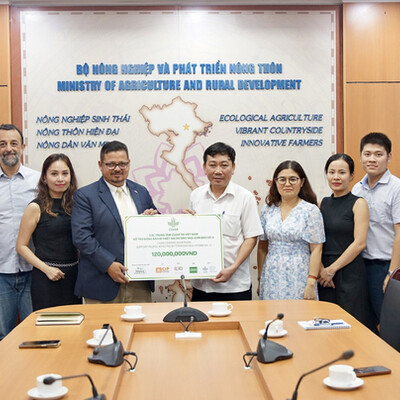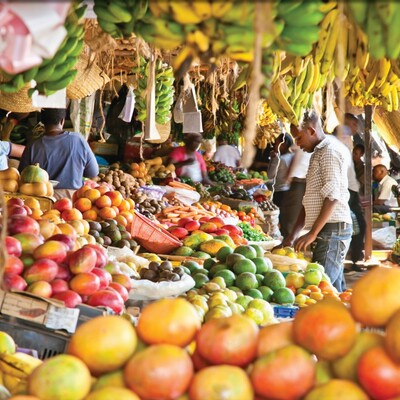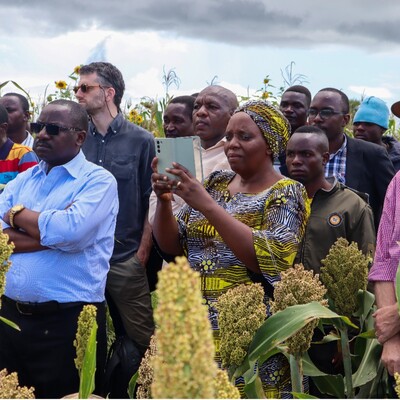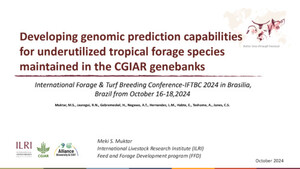
The future of livestock in the developing world: myths, complexities and trade-offs
The future of livestock in the developing world was one of the principal themes at the third International Tropical Agriculture (TropAg) Conference held from 11-13 November 2019 in Brisbane, Australia.

From left: Lindsay Falvey, Robyn Alders, Shirley Tarawali, Richard Eckard, Rebecca Doyle, Mario Herrero and Anna Okello
The conference focused on the challenge of feeding the world’s ever-growing population, which is expected to reach 9.8 billion by 2050. The greatest challenges will come from countries in the world’s tropical zone, currently home to half the world’s population. Livestock is expected to play an important role in their nutrition and livelihoods, even as the sector comes in for various criticisms in the developed world.
The International Livestock Research Institute’s (ILRI) Board chair, Lindsay Falvey, who is also a professor at the University of Melbourne, Australia, led a session on sustainable, healthy diets for all that included a keynote presentation from Lawrence Haddad and additional presentations from several Australia-based researchers, including Robyn Alders, Centre for Global Health Security, who spoke on public and policy opportunities to support sustainable livestock; Mario Herrero, Commonwealth Scientific and Industrial Research Organisation (CSIRO), who spoke on some of the myths about livestock and the environment. They were followed by three scientists who spoke about some recent success stories on livestock: Richard Eckard, The University of Melbourne, on the potential for methane reduction; Rebecca Doyle, The University of Melbourne, on animal welfare and farm intensification; and Anna Okello, Australian Centre for International Agricultural Research (ACIAR), on opportunities to transform food systems in developing regions. ILRI’s assistant director general, Shirley Tarawali, facilitated the discussion that ensued after the presentations.
Several broad themes emerged from the presentations. First, despite increasing concern about livestock in the developed world, animal-source foods (ASFs) play a huge role in developing world diets and livelihoods. This is unlikely to change given the increased demand for ASFs in the LMICs, itself a result of increasing population, incomes and urbanization. However, the smallholders who produce most ASF in the developing world face numerous challenges. They are losing out on value chains and access to market opportunities. The focus on reducing emissions by cutting back on livestock production means that not enough work is being done to mitigate per unit GHG emissions. More can be done to encourage improved animal welfare. Several speakers noted that the research to policy and implementation pipeline is not as efficient or as effective as it could be.
Haddad’s presentation focused on why animal source foods need to be part of the global food security and nutrition agenda, despite some recent criticism of the livestock sector from scientists and activists in the developed world. He had two simple, bottom-line messages:
- Animal source foods are essential for infant and young child growth (for example, 59% of the world’s children are not fed much-needed nutrients from animal source foods);
- Too many children under 5 have micronutrient deficiencies (for example, approximately 70% of children in sub-Saharan Africa suffer from micronutrient deficiencies).
But recent scientific reports, including the Food in the Anthropocene, also known as the EAT-Lancet report, have focused largely on the negative health and environmental consequences of eating too much ASF, problems that predominate in the developed world. In fact, there is very little correlation between health and low carbon diets, and South Asia and Sub Saharan Africa are well below the EAT Lancet recommendations for ASF. In the end, balancing concerns for the environment, livelihoods and individual health outcomes means taking a contextual approach.
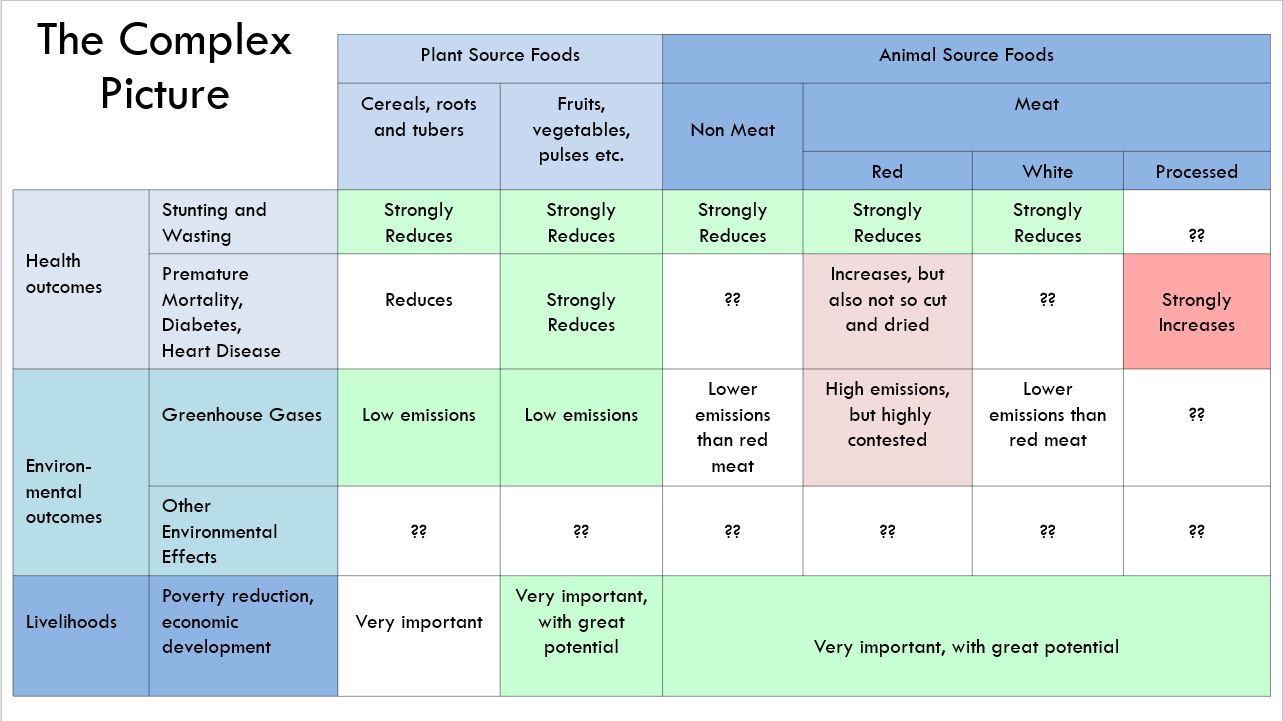
The bottom line: In high-income countries, policymakers should focus on reducing ASF consumption for both health and environmental reasons; in low-income countries, the focus should be on increasing ASF consumption for nutritionally vulnerable groups, reducing GHG emissions of ASF production, and enhancing livelihood impacts from increased livestock productivity.
Alders focused her presentation on the quest for policy and public expenditure opportunities to support implementation of livestock and aquaculture interventions. She noted that most of the world’s farms are small and family-run. Small farms operate about 12% of the world’s agricultural land whereas family farms operate about 75% of the world’s agricultural land. About half of people surviving on less than $1.9 dollars a day depend on livestock for their livelihoods. LMICs also account for about 80 percent of the world’s aquaculture production. The bad news is that globalization of value chains and increasing demands for certification appear to be marginalizing small-scale producers.
The strategy developed in 2018 in conjunction with various partners aims at recognizing that market failures undermine small-scale producers. Understanding how country-led policy and public expenditure can transform agriculture as well as the economy is critical if we are to improve the performance of market-oriented small-scale producers.
Working with Chatham House, Alders is developing a policy-relevant decision toolkit to identify supportive smallholder aquaculture and livestock practices, and to innovate value chains that deliver across the triple bottom line of economic sustainability, environmental sustainability, and social sustainability.
Alders next discussed the implementation process for policy action. The first step is a matter of conducting a literature review and synthesizing global, regional and national policy plans; collecting key informant interview and county case study findings; and identifying secondary data tools and agreed indicator checklists. The next step involves public consultation and peer reviews, followed by national roundtables with guided scenario discussions, after which participants engage in a triangulation of findings and analysis. The final phase is the identification of examples of enabling or inhibitory policies and policy-relevant investment options and tradeoffs in support of gender- and nutrition-sensitive economically, environmentally and socially sustainable animal (ruminant and poultry) and aquaculture (fresh and saltwater) systems. By focusing on how to improve the performance of market-oriented small-scale producers, the goal is to show how country-led policy and public expenditure can contribute to inclusive agricultural transformation, empowered women and well-nourished families and ultimately a transformed economy.
Herrero focused his discussion on facts and myths about livestock and the environment. He began by noting that some of the major issues affecting livestock include the large and growing size of the sector; the way it is misunderstood by scientists and consumers; the widespread prevalence of unproven generalizations about the sector; the fact that it is dynamic and complex, encompassing both good and bad aspects; and the way it has been mis-represented in the press.
 Herrero provided an excellent statistical overview of the state of the livestock sector globally. In 2002, the annual per capita consumption of meat and milk in developing states was 28kgs and 44kgs respectively; this is expected to rise to 44kgs and 78kgs respectively by 2050. Even in the developed world, per capita consumption of meat and milk is expected to rise from 78kgs and 202kgs to 94kgs and 216kgs, respectively. These numbers, however, mask a wide variation in over and under consumption of various ASF in different regions.
Herrero provided an excellent statistical overview of the state of the livestock sector globally. In 2002, the annual per capita consumption of meat and milk in developing states was 28kgs and 44kgs respectively; this is expected to rise to 44kgs and 78kgs respectively by 2050. Even in the developed world, per capita consumption of meat and milk is expected to rise from 78kgs and 202kgs to 94kgs and 216kgs, respectively. These numbers, however, mask a wide variation in over and under consumption of various ASF in different regions.
The environmental efficiency of livestock has been improving, but the sector has traded lower land use, and emissions for increased nitrogen use. He made several recommendations regarding how livestock could improve its environmental impact: The beef sector should explore more low-opportunity-cost lands and become more of a by-product of the dairy sector; dairy should focus on smallholder gains, as there is a lot of demonstrated evidence of the benefits of intensification for livelihoods benefits. It should also pursue more circular feed possibilities, to decouple livestock from the negative impact of unnecessary environmental costs.
Eckard focused on a specific example of success: The potential for livestock methane mitigation. He introduced his speech by noting that the livestock sector is under increasing pressure to reduce its control its greenhouse gas emissions (GHG). There are broad social and economic currents affecting ASF consumption: Vegetarianism is increasing in the developed world even as demand is increasing in the developing world. The Paris Climate Agreement specified that all countries and businesses would aim to reduce their emissions to zero or offset them entirely by 2050. Livestock (mostly in the form of cow burps) currently responsible for 14.5% of GHG, so it will be a challenge to meet the Paris target. Various initiatives have been undertaken to ensure that livestock are carbon neutral; these include Mato Grosso do Sul, in Brazil, Meat and Livestock Australia, and Carbon neutral red-meat in Australia.

Pathways to reduce enteric methane emissions
Public discussion on reducing GHG from livestock tends to focus on reducing demand, however it is also possible to focus on making the supply of ASF more environmentally efficient, an option presents an opportunity for improving rather than harming the livelihood of livestock producers. In broad terms, there are three ways to proceed: by manipulating the animal, the diet, or the rumen. One could make animals more efficient, for example, thereby reducing the amount of GHG they emit per unit of food. Or one could add algae, seaweed or dietary supplements to the animals’ feed, which have been shown to cause animals to reduce their GHG emissions.
In summary, at the moment the potential for significant GHG abatement on intensive farm systems is high, but considerably more limited on extensive or subsistence systems. That points to the need for more research on low-cost, intergenerational, and sustainable solutions. Moreover, there is also need for a global collaboration, and a greater understanding that from partner institutions and donors that the issue cannot be addressed within traditional 3-year funding paradigms.
Doyle focused her presentation on the question of whether one could achieve productivity gains through intensification while also benefiting animal welfare. Are there, as she suggests, synergies or trade offs to be had? She began by noting the rise of alt-meat products such as Impossible Foods, whose mission statement is to ‘completely replace the use of animals as a food production technology’. It’s clear that animal welfare is growing in importance and that having high animal welfare standards can be a major contributor to improved animal production and contribute to the ongoing acceptability of meat consumption.
Doyle proposed an animal welfare sensitive approach, building an evidence base founded on scientific welfare assessment; connecting with farmers and fostering positive attitudes; and understanding as well as investing in positive welfare systems. What would such an approach entail? Identifying losses and target areas; measuring improvements; increasing opportunities for product differentiation; establishing common indicators; and promoting transparency. Moving toward such an approach would require working with farmers to foster positive attitudes towards animal care, encouraging an active management style among farmers as well as inspiring positive attitudes to actions and fostering the belief in perceived control over the outcome.
She concluded by observing that taking a welfare sensitive approach to animal production will help meet the demands of this changing sector and foster good opportunities for producers and their animals.
Okello spoke on some promising opportunities that exist to transform food systems in tropical developing regions. She works for the Australian Centre for International Agriculture Research (ACIAR), which is in the foreign affairs group funded by the Australian ODA budget. It seeks to boost agricultural productivity, sustainability and food security in smallholder systems in partner countries. It has spent $120+ million in more than 200 R4D projects in over 30 countries through 10 regional offices. The organization prioritizes individual and institutional capacity building, impacts evaluation and learning lessons. The three ‘Pillars’ of the ACIAR Livestock Program are climate; trade and market access; and human health, nutrition and wellbeing. Its premise is that better evidence of the total societal contribution of livestock in LMICs is required to contribute to the global debate on the future role of livestock.
The livestock sector is valuable in that livestock act as source foods; generate income; add value to crop productivity; act as financial instruments and indicators of social status. They also help in multidimensional ways through gender. Despite these benefits, there are numerous challenges to increasing smallholder livestock productivity. Among them: a dearth of public and private investment; the difficulty entering formal markets; ‘Bulky’ cash flow; and poor conversion of the ‘non-monetary’ value of livestock. The goal of sustainable livestock intensification promises increased productivity of land and livestock, expanded grazing opportunities and increased commercial production.
But this will not be easy to accomplish. For example, transformational change in livestock feed can be constrained by existing grazing systems; the use of crop residues to feed livestock; and using alternate feed sources. Transformational change in mechanisation requires movement from draft to cow-calf systems, improving farm-power balance, and addressing change in livestock landscape that might reduce the value added from draught animal labor. Transformational change in technology includes using digital tools, block chain technologies, and disruptive technologies. Transformational change in policy and economics research include addressing disconnect between livestock policy and livestock value systems, learning from other sectors, and facilitating policy processes. None of these transformational changes will come easily.
ACIAR’s research perspective is informed by the understanding that merging science and development requires more than just technical research approaches. It is vital to understand smallholder perspectives on livestock intensification, and consider the future impact of ‘development’ on smallholders’ relationship with livestock and food systems.
ILRI’s Tarawali led the discussion that closed out the session. It focused on several emerging problems that scientists and policymakers must wrestle with
- How will farm size change with intensification? What will happen to the medium sized farmers? The consensus seemed to be that there isn’t much information on this. It seems as if smaller farms are disappearing as countries become more developed, but we still don’t fully understand what will this mean for ruminant farmers in particular.
- There was a sentiment that developing countries are more open to agricultural innovation and support and have much more intuitive systems compared to the production systems of high-income countries.
- Two issues arose regarding animal welfare: The first is that the topic is not receiving the scientific attention in should be, and as a result the field may not be making enough progress. And the second issue is whether the focus on welfare, is more of a first world country concern compared to a third world concern.
- Finally, there was strong consensus in the need for a more multidisciplinary approach. As one participant noted, we need not just the scientists and policymakers, but the actual farmers themselves, in more than a multi-disciplinary, but a trans disciplinary type approach. ‘You need everybody in the room, physically. You need everybody on site and talking, figuring out what research is needed in order to genuinely address these challenges’.








